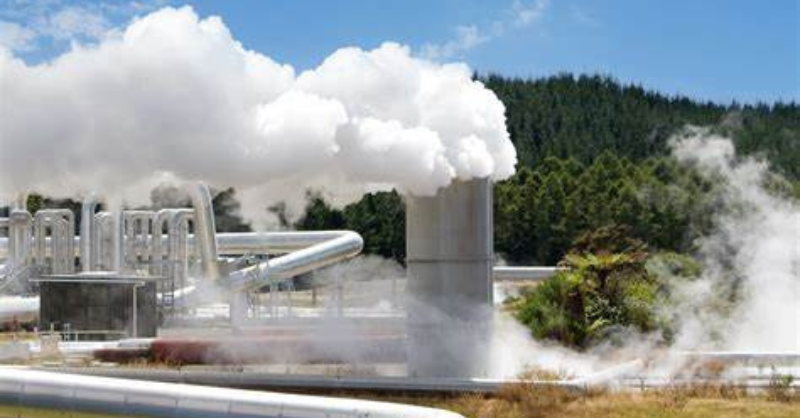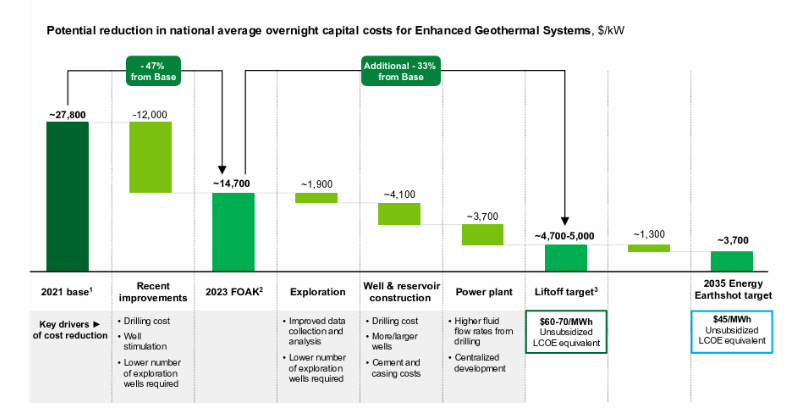
Sunday Brunch: Geothermal as a solution - but not just yet
One of the challenges around renewables based electricity grids is coping with the periods when the variable generation sources, such as wind and solar, are insufficient to meet demand. Which is where geothermal has a role.
Geothermal power technology has shown compelling advances that can enable it to become a key contributor to secure, domestic, decarbonized power generation for the US as a source of clean firm power - US Department of Energy 2024
One of the challenges around renewables based electricity grids is coping with the periods when the variable generation sources, such as wind and solar, are insufficient to meet demand. Part of the answer is moving the demand, which is easier and more effective than you might think. The other part is having low carbon sources of generation, that we can dial up & down when we need them. This is where geothermal could play a part.
It's clear that Next Generation Geothermal offers the potential to materially assist in decarbonising our electricity supply system. How? By offering both clean firm power (always producing - what used to be called baseload power) and clean flexible/dispatchable generation.
That is the good news, especially the dispatchable generation element. As the percentage of wind & solar on our electricity grid rises, we are going to need flexible supply to fill the gaps when renewables are insufficient to meet demand. And the most 'valuable' form will be long duration storage - which is where geothermal supply can sit, making it especially valuable.
But, we also need a note of caution. In much the same way that some commentators leap on every problem as being terminal for the net zero transitions, it's also possible to be overly optimistic. Even at full potential, geothermal will only be able to meet part of the demand for long duration storage. And it's going to remain expensive. Plus, it's more of a 2030's onward part of the solution. So we need to think about it as part of the tool kit of solutions, not the total answer.
It's one of the tougher aspects of how we need to think about the electricity grid of the future. It's complicated. There will be lots of elements, from more renewables, to geothermal, pumped storage hydro, batteries and interconnectors. Plus demand management will become really important. And sadly, the human race likes simple solutions. We don't cope well with complexity.
That doesn't mean we shouldn't get excited about the potential of geothermal. It should have a place in most investors portfolio of longer term electricity decarbonisation solutions. But don't over promise.
If you want to read the rest and are not already a member...

Geothermal as a solution - but not just yet
I grew up in New Zealand. Because of our location on the Pacific Ring of Fire we have a lot of earthquakes. And the same geological conditions that led to us being earthquake prone also enabled us to have 'always on' geothermal electricity. But New Zealand is the exception. In most of the world traditional geothermal electricity is not possible.
What is geothermal electricity generation? It's using the naturally occurring supply of heat within the earth's subsurface to heat fluids, which in turn are used to spin turbines to create electricity. In theory, there is enough geothermal energy to power the entire world thousands of times over. But in practice, it's hard to deliver this energy in a cost effective way.
Looking just at the US, there is around 40 GW of estimated conventional geothermal resource, of which only 25% is currently identified. This generates circa 3.7GW of electricity, which is about 0.4% of total US electricity production. So a lot smaller than say hydro. And remember the US has more installed geothermal than anywhere else.
The good news is that what is known as Next Generation Geothermal (also called Enhanced Geothermal Systems or EGS) is starting to change this. Next Generation Geothermal is very different from the traditional hydrothermal generation we are used to. As the US Department of Energy puts it in a recent report, "next-generation geothermal technologies make their own reservoirs from ubiquitous hot rock, rather than hunting for naturally occurring reservoirs in unique locations".

This doesn't mean we could have geothermal electricity generation anywhere, but it massively expands the potential.
And perhaps more importantly, Next Generation Geothermal not only offers the potential for geothermal to be sited in a much wider range of locations. It also allows it to be used for flexible, dispatchable electricity. This is because it can utilise a loop system (either open using fracking or a closed loop).

Putting this in layman's terms, this new geothermal can ramp supply up and down depending on system demand. Which means it can supply electricity when renewable resources such as wind and solar are insufficient. This would enable geothermal to replace the existing use of fossil fuel 'peaker plants', enabling further decarbonisation of our electricity systems.
If you want to understand more about how this new next generation geothermal works, how it differs from traditional geothermal, and some of the challenges it might face, I suggest you read a blog we wrote back in June 2023.

For this Sunday Brunch I want to focus on two issues. Just how much new geothermal there could be in the future. And how much might it cost?
How much geothermal could there be in the US?
Next generation geothermal technologies could expand geothermal resource potential to 5,500 GW. Remember that conventional geothermal resources are around 40GW. And while this potential is mainly concentrated along the west and south coasts (the red area), there is still a lot of resource elsewhere.

Obviously, not all of this potential can be turned into variable electricity generation sites, mainly due to cost constraints. There are three broad scenarios.
The first is that if expected cost reductions are realised and the Energy Earthshot target is reached by 2035, there is an opportunity for 90-100 GW of next-generation geothermal on the grid by 2050. Around 30GW of this could be deplyed by 2035. This would be c. 25x what is available now.
The second scenario relates to a possible shortfall of land availability for other renewables, making next generation geothermal more financially attractive. This would add an extra c. 30GW.
And then finally, scenario three. If the technical issues around using next generation geothermal for long duration storage are resolved, the total could go up to c. 170GW.

And how does this compare with expected demand? To quote from the report "System-level decarbonization modeling suggests that the U.S. will need to quadruple the existing clean firm power supply available on the grid today, adding between 700 and 900 GW by 2050 to build a decarbonized, functioning grid system capable of supporting wind and solar buildout and increased demand".
So even at the high end of projected supply of next generation geothermal (c. 170GW), the market would not even be close to saturated. But then again, as we highlighted earlier, next generation geothermal is not the silver bullet either. We are still going to need other technologies such as pumped storage hydro, batteries and of course, interconnectors.
What about cost?
The biggest constraint on exploiting the geothermal potential is the up front capital cost. It is estimated that in 2021 the upfront cost to produce 1 KW of next generation geothermal electricity was c. $27,800. By 2023 this had fallen to c. $14,700. And the target is to get it down to between $3,700 to $5,000 by 2035.

This would equate to a break even price for the electricity produced of c. $45 to $70/MWh. This compares with recently agreed geothermal power purchase agreements (PPA's), which are being signed at between $70 and $100/MWh.
And by 2035 next generation geothermal costs could be similar to the costs of other clean firm power sources. The most recent NREL Annual Technology Baseline analysis has enhanced geothermal systems (EGS) at $71/MWh, compared with $66/MWh for nuclear, and $64/MWh for gas with CCS.
All of this means that if the cost reduction for next generation geothermal continues as expected, by 2035 it could be broadly cost competitive with similar clean firm power sources. Which in turn could mean that by then there could be c. 170GW of geothermal electricity supply in the US, compared with only 3.7GW now.
All of this means that next generation geothermal investment should have a place in most sustainable investment portfolios. No, it's not the solver bullet to the long duration storage challenge, but it is part of the answer. And let's recognise the challenges we face along the way.
Something a little more bespoke?
Get in touch if there is a particular topic you would like us to write on. Just for you.
Contact us
Please read: important legal stuff.



